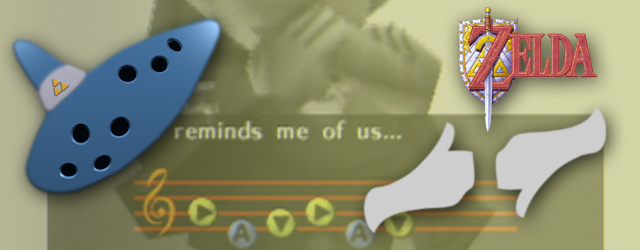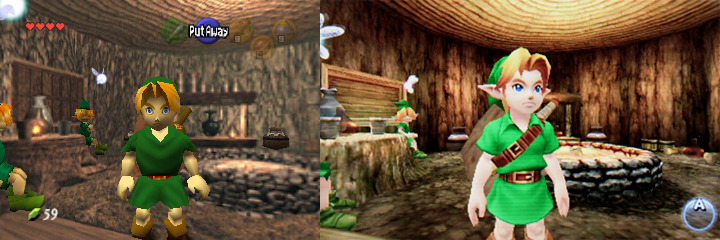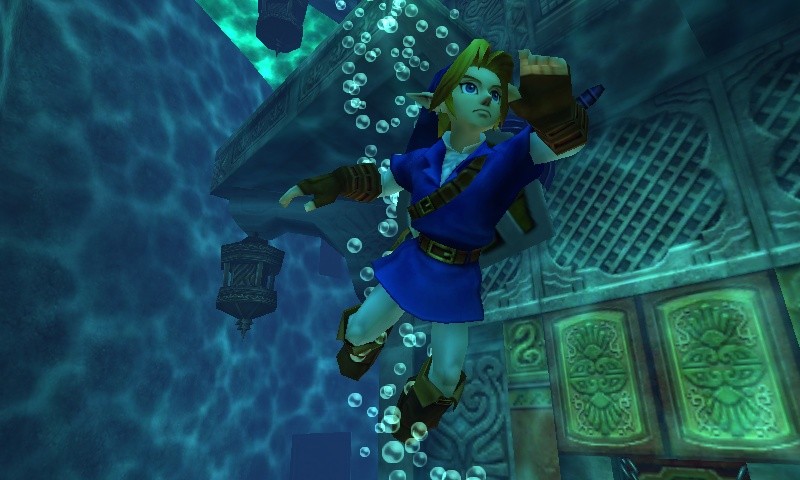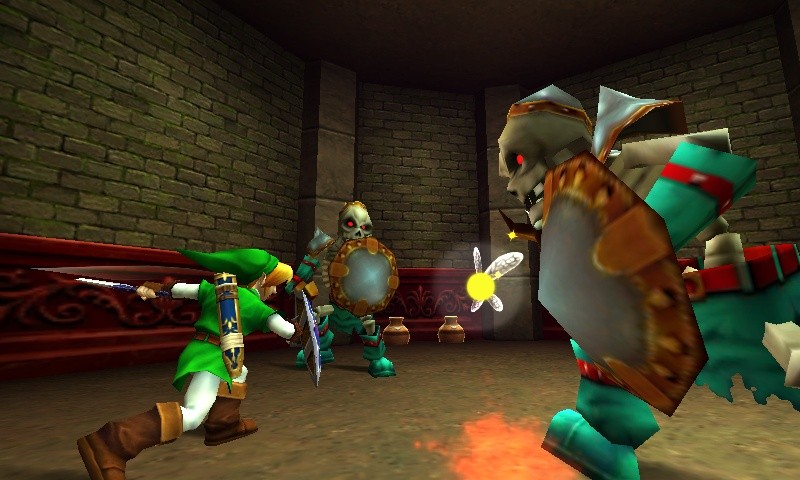
The Legend of Zelda: Ocarina of Time is considered one of the greatest games ever made, if not the greatest. After waiting years for a console follow-up to what is still one of my favorite titles, A Link to the Past, I made the 45 minute drive after classes to the closest Electronics Boutique so I could have my copy on release day. After about a week of playing I realized the trip was a waste of gas.
I’m well aware that I’m in the minority, but I don’t like Ocarina of Time. In fact, I kind of despise it. It took the Zelda series in a direction that for me was unwelcome. When the 3DS remake was announced, I initially paid no attention to it, but then I remembered that while Nintendo does love to bring back their classics, they usually return with a fresh coat of paint and some new features. Maybe this was just what I needed to jump back into Ocarina and give it another chance.
The first issue I have with the game is something that shiny new graphics won’t fix. What I loved about the four Zelda titles that came before Ocarina was the exploration, as that was the basis for those games. Even the tale about the game’s concept being derived from Miyamoto exploring the woods as a child sets that framework. Although Zelda II: The Adventure of Link alternated between top down and side scrolling levels, along with adding an experience and level progression system, it still involved a good amount of exploration.
Link and everything else looks way, way better.
This aspect of Zelda is heavily diminished in Ocarina of Time. I’m not saying it’s gone, just diminished. I used to think that putting Link in a 3D world was part of the issue. It created a land so vast that exploring every nook and cranny became more of a chore than a delight, mainly because that vastness was fairly empty. An interview with the team who worked on A Link to the Past revealed that they wanted to fill the entire world so each frame was unique and loaded with content, which is one of the reasons I loved it. While praise for Hyrule Field’s enormity in Ocarina was a trend in those initial reviews, I couldn’t understand why that was, as the land was so barren, quite the opposite of A Link to the Past. With the exception of Lon Lon Ranch, everything was slammed against the edges of the map.
A number of hidden areas were very repetitive as well: fall down a hole that you find with a bomb, or maybe under a gravestone, walk to the treasure chest, get a mediocre reward like five rupees, and then go about your business. While previous titles had places like this, what I felt was truly missing from Ocarina that was abundant in the previous games was the sense of discovery. The map may have been telling me to go one way, but I would go the other, wanting to see as much as I possibly could. Eventually I’d find areas that were inaccessible, but I knew they wouldn’t be that way forever. I knew that in some dungeon, some hidden cave, or maybe a hole covered up by some grass, I’d find whatever I needed to get across that broken bridge or finally touch the tablet just out of reach at the top of a mountain. Ocarina didn’t have that. Everywhere you went felt like you were supposed to be there, and that you had to do things in proper succession. Sure you can complete palaces out of order in the same way you could in previous Zelda titles, but it felt more like you were just moving cogs around in a machine rather than having a bit of free will.
Getting back to the question at hand, did Ocarina of Time 3D do anything to make exploration better? Well, this is still essentially the same game, so better is a strong word, however its improved visuals make it much more tolerable. The Nintendo 64 and PlayStation were both of an era where games were doing way too much than what their hardware could handle, but of course Nintendo managed to come up with good looking games using what they had. The same can even be said now in a time where Wii is quite underpowered compared to its competition, yet Nintendo titles still shine. Despite their ability to create beauty when others couldn’t, some of the areas in Ocarina still looked very bland. Jump to today and you can’t deny that Ocarina of Time 3D looks great. During my first few hours of play, exploring felt less tedious and actually quite enjoyable. While the hidden areas were still repetitive, those first few hours gave me a glimmer of hope that maybe I could join the millions who fell in love with this game.
Inventory management helps in the Water Temple…but just a little.
One issue that is remedied quite well is inventory management. Everything is taken care of through the touch screen which makes things much simpler. Also there are two extra slots for items, essentially allowing you to have four active items available at any time. This simple addition makes one painful element of the game no longer a concern. Unfortunately, an improved inventory management system, in addition to the graphical overhaul, can’t fix the biggest problem that I have with the game: combat.
First, let’s give credit and praise for one of Ocarina’s biggest innovations: Z-targeting. This is a concept that seems so obvious now, but in those early days of going from 2D to 3D game development it was a welcome innovation that has transitioned over to many titles since. One concern going into Ocarina of Time 3D was that instead of Z-targeting, there would be L-targeting, and while I certainly have no discrimination to any letters, my issue is with how tiny that button is, and how painful it could be to hold down. Thankfully in the options the ability to just tap to target and let go is still available. In my case, and possibly in the case of others, this is actually the first time I used this option rather than holding down a button, and I’ve found it to be a great improvement.
Everything else related to combat still falls flat for me. Using the “cheese and macaroni” comparison, where Ocarina of Time is an action/adventure game, the prior four Zelda titles were more adventure/action. Combat was almost incidental with the exception of bosses, which were more like puzzles than battles. If anything the most enjoyable battles in Ocarina were the bosses. I also had no issue with the trivial enemies as they felt more like a natural progression of the combat (if you can even call it that) of the prior games. One of the fallbacks of targeting is that it shares the same button as camera centering. In the heat of battle you may think you’re about to lock onto an enemy, but instead your camera swings around and now you can’t even see them, but instead are frantically trying to lock on again. This is especially frustrating when you’re trying to get some hits in on a boss that is stunned for a few moments before it goes back to their set pattern.
Fights like this weren’t a Zelda staple until Ocarina.
A recent Iwata Asks revealed that I wasn’t crazy; the game was developed to focus on combat. As Iwata says during the interview, “it began with the single theme of making a Zelda game that included chanbara-style swashbuckling.” Obviously it was a good idea since the game was both a critical and commercial success. While I understand that games will always evolve, it’s rare to see them change the entire theme of the series. Even though something like Metroid Prime was a dramatic change in appearance and perspective, anyone who has played it will agree it didn’t become a first person shooter; it was still about the exploration. The combat, except for the bosses, was incidental, just like the previous three titles, and, just like Ocarina, even the bosses felt like a puzzle rather than a fight.
I could go on with additions to the 3DS version, such as the Super Guide spin-off “visions”, or continue with critique of the original, such as the tactics used to control players down a certain path (like bomb bags or the wallet system), but the former makes no improvements and the latter could not have been altered.
That said, there’s no question any fan of this game needs to pick up a copy of the 3DS version. Its graphical enhancements and inventory improvement are enough of an excuse for you to play Ocarina again, and on the go at that. For the few others like myself who didn’t enjoy it, ask yourself why and then assess if it’s worth another look. If you’re clamoring for a better experience with combat or more exploration then you’re not going to get that, and honestly I didn’t expect those kinds of changes, but I’m always willing to give something a second chance. When it comes to classic-style Zelda games based around exploration with no gimmicks, someday I hope Nintendo decides to give that a second chance as well.
Just make sure pig Ganon is in it.




 ShareThis
ShareThis










My first Zelda was Link’s awakening DX on the GBC. I adored it. Not long after I played Ocarina on a second-hand N64. I liked it a lot at first, but as it went on I liked it less and less.
I have never been quite sure why. I think the greeny-browny color scheme got me down a bit – I do like my games colorful! And then I never liked adult Link as much as child Link. I didn’t end up finishing it.
I am not sure if I am going to give the 3D version a try or not. I may just wait for Dr Lautrec!
I love when people mention Link’s Awakening because that was my second– and to date favorite– Zelda game. It’s just got so much charm to it, and so much lightheartedness. But I’ve talked enough about Koizumi’s little brainchild too much ;)
I don’t blame you. That targeting problem has become especially problematic since the gyroscope, because it wants to set on where you were pointing the 3DS previously. If you do preset the 3DS physically before you go into targeting view, the gyroscope’s going to give you problems, and I’m not just talking about the 3D.
Still, even in the original Ocarina, it was never my favorite. I liked it but I thought it was “okay.” Link’s Awakening was my number one until Twilight Princess where I think they took Ocarina and made it even better.